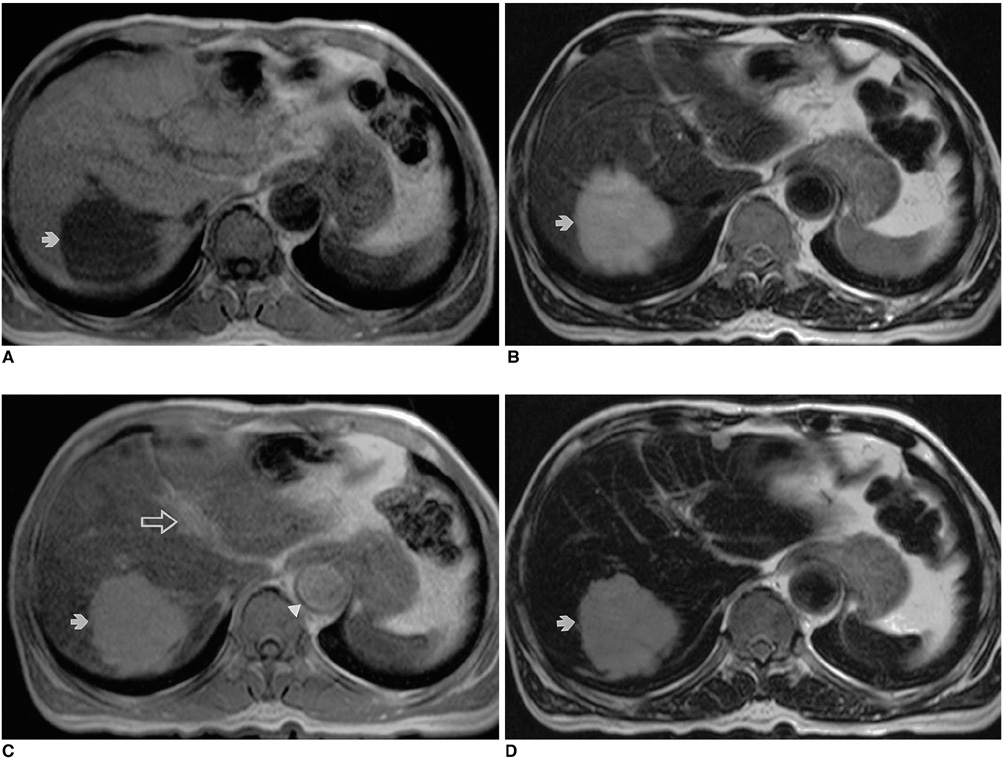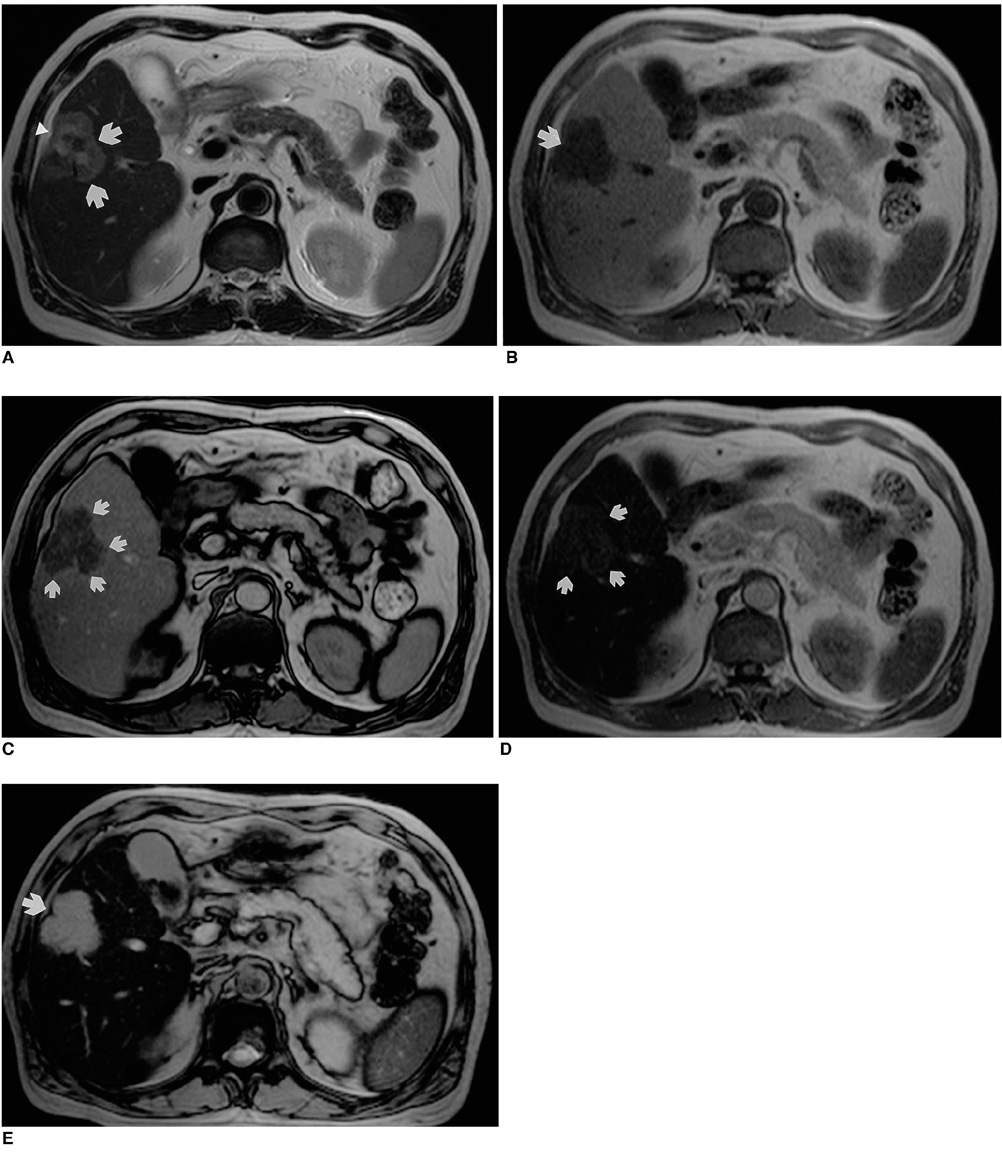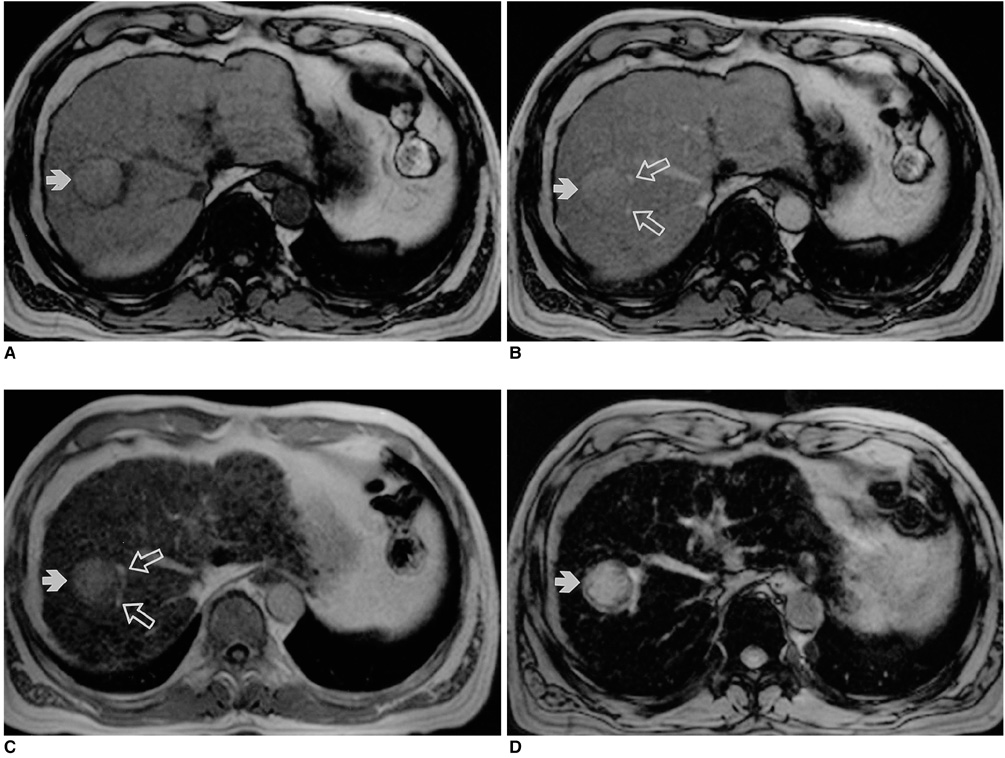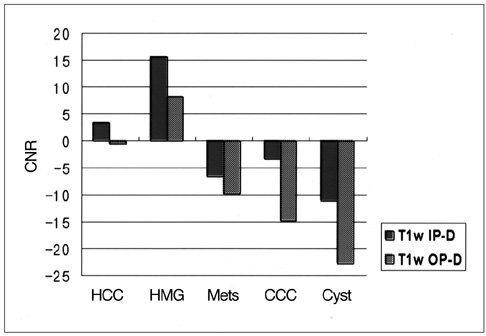Korean J Radiol.
2003 Mar;4(1):9-18. 10.3348/kjr.2003.4.1.9.
Characterization of Focal Liver Lesions with Superparamagnetic Iron Oxide-Enhanced MR Imaging: Value of Distributional Phase T1-Weighted Imaging
- Affiliations
-
- 1Department of Radiology, Seoul National University College of Medicine, Seoul, Korea. leejm@radcom.snu.ac.kr
- 2Department of Diagnostic Radiology, Chonbuk National University, Chonju, Korea.
- 3Department of Radiology, Wonkwang University Hospital, Iksan, Korea.
- KMID: 754037
- DOI: http://doi.org/10.3348/kjr.2003.4.1.9
Abstract
OBJECTIVE
To determine the potential value of distributional-phase T1-weighted ferumoxides-enhanced magnetic resonance (MR) imaging for tissue characterization of focal liver lesions. MATERIALS AND METHODS: Ferumoxides-enhanced MR imaging was performed using a 1.5-T system in 46 patients referred for evaluation of known or suspected hepatic malignancies. Seventy-three focal liver lesions (30 hepatocellular carcinomas [HCC], 12 metastases, 15 cysts, 13 hemangiomas, and three cholangiocarcinomas) were evaluated. MR imaging included T1-weighted double-echo gradient-echo (TR/TE: 150/4.2 and 2.1 msec), T2*-weighted gradient-echo (TR/TE: 180/12 msec), and T2-weighted turbo spin-echo MR imaging at 1.5 T before and after intravenous administration of ferumoxides (15 mmol/kg body weight). Postcontrast T1-weighted imaging was performed within eight minutes of infusion of the contrast medium (distributional phase). Both qualitative and quantitative analysis was performed. RESULTS: During the distributional phase after infusion of ferumoxides, unique enhancement patterns of focal liver lesions were observed for hemangiomas, metastases, and hepatocellular carcinomas. On T1-weighted GRE images obtained during the distributional phase, hemangiomas showed a typical positive enhancement pattern of increased signal; metastases showed ring enhancement; and hepatocellar carcinomas showed slight enhancement. Quantitatively, the signal-to-noise ratio of hemangiomas was much higher than that of other tumors (p < .05) and was similar to that of intrahepatic vessels. This finding permitted more effective differentiation between hemangiomas and other malignant tumors. CONCLUSION: T1-weighted double-echo FLASH images obtained soon after the infusion of ferumoxides, show characteristic enhancement patterns and improved the differentiation of focal liver lesions.
Keyword
Figure
Reference
-
1. Hagspiel KD, Neidel KFW, Eichenberger AC, Weder W, Marincek B. Detection of liver metastases: comparison of superparamagnetic iron-oxide-enhanced MR imaging at 1.5 T with dynamic CT, intraoperative US, and percutaneous US. Radiology. 1995. 196:471–478.2. Pena CS, Saini S, Baron BL, et al. Detection of malignant primary hepatic neoplasms with gadobenate dimeglumine (Gd-BOPTA)-enhanced T1-weighted hepatocyte phase MR imaging: results of off-site blinded review in a phase-II multicenter trial. Korean J Radiol. 2001. 2:210–215.3. Kim SH, Choi D, Lim JH, et al. Optimal pulse sequence for ferumoxides-enhanced MR imaging used in the detection of hepatocellular carcinoma: a comparative study using seven pulse sequences. Korean J Radiol. 2002. 3:87–97.4. Bluemke DA, Paulson EK, Choti MA, DeSena S, Clavien PA. Detection of hepatic lesions in candidates for surgery: comparison of ferumoxides-enhanced MR imaging and dual-phase helical CT. AJR Am J Roentgenol. 2000. 175:1653–1658.5. Kanematsu M, Itoh K, Matsuo M, et al. Malignant hepatic tumor detection with ferumoxides-enhanced MR imaging with a 1.5-T system: comparison of four imaging pulse sequences. J Magn Reson Imaging. 2001. 13:249–257.6. Choi DI, Kim SH, Lim JH, et al. Preoperative detection of hepatocellular carcinoma: ferumoxides-enhanced MR imaging versus combined helical CT during arterial portography and CT hepatic arteriography. AJR Am J Roentgenol. 2001. 176:475–482.7. Karhunen PJ. Benign hepatic tumors and tumor-like conditions in men. J Clin Pathol. 1986. 39:183–189.8. Grangier C, Tourniaire J, Mentha G, et al. Enhancement of liver hemangiomas on T1-weighted MR SE images by superparamagnetic iron oxide particles. J Comput Assist Tomogr. 1994. 18:888–896.9. van Gansbeke D, Metens TM, Matos C, et al. Effects of AMI-25 on liver vessels and tumors on T1-weighted turbo-field-echo images: implications for tumor characterization. J Magn Reson Imaging. 1997. 7:482–489.10. Mergo PJ, Helmberger T, Nicolas AI, Ros PR. Ring enhancement in ultrasmall superparamagnetic iron oxide MR imaging: a potential new sign for characterization of liver lesions. AJR Am J Roentgenol. 1996. 166:379–384.11. Parley M, Mergo PJ, Torres GM, Ros PR. Characterization of focal hepatic lesions with ferumoxides-enhanced T2-weighted MR imaging. AJR Am J Roentgenol. 2000. 175:159–163.12. Nakayama M, Yamashita Y, Mitsuzaki K, et al. Improved tissue characterization of focal liver lesions with ferumoxide-enhanced T1- and T2-weighted MR imaging. J Magn Reson Imaging. 2000. 11:647–654.13. Kim JH, Kim MJ, Suh SH, Chung JJ, You HS, Lee JT. Characterization of focal hepatic lesions with ferumoxides-enhanced MR imaging: utility of T1-weighted spoiled gradient- recalled echo images using different echo times. J Magn Reson Imaging. 2002. 15:573–583.14. Oswald P, Clement O, Chambon C, Schouman-Claeys E, Frija G. Liver-positive enhancement after injection of superparamagnetic nanoparticles: respective role of circulating and uptaken particles. Magn Reson Imaging. 1997. 15:1025–1031.15. Hamm B, Thoeni RF, Gould RG, et al. Focal liver lesions: characterization with nonenhanced and dynamic contrast material-enhanced MR imaging. Radiology. 1994. 190:417–423.16. Yamashita Y, Hatanaka Y, Yamamoto H, et al. Differential diagnosis of focal liver lesions: role of spin-echo and contrast-enhanced dynamic MR imaging. Radiology. 1994. 193:59–65.17. Yoshida H, Itai Y, Ohtomo K, et al. Small hepatocellular carcinoma and cavernous hemangioma: differentiation with dynamic FLASH MR imaging with Gd-DTPA. Radiology. 1989. 171:339–342.18. McFarland EG, Mayo SW, Saini S, et al. Hepatic hemangiomas and malignant tumors: improved differentiation with heavily T2- weighted conventional spin-echo MR imaging. Radiology. 1994. 193:43–47.19. Oudkerk M, van den Heuvel AG, Wielopolski PA, Schmitz PI, Borel Rinkes IH, Wiggers T. Hepatic lesions: detection with ferumoxides-enhanced T1-weighted MR imaging. Radiology. 1997. 203:449–456.20. Reimer P, Müller M, Marx C, et al. T1 effects of a bolus-injectable superparamagnetic iron oxide, SH U 555 A: Dependence on field strength and plasma concentration - preliminary clinical experience with dynamic T1-weighted MR imaging. Radiology. 1998. 209:831–836.21. van Beers B, Gallez B, Pringot J. Contrast-enhanced MR imaging of the liver. Radiology. 1997. 203:297–306.22. Petersein J, Saini S, Weissleder R. Liver. II: Iron oxide-based reticuloendothelial contrast agents for MR imaging. Clinical review. Magn Reson Imaging Clin N Am. 1996. 4:53–60.
- Full Text Links
- Actions
-
Cited
- CITED
-
- Close
- Share
- Similar articles
-
- Focal Nodular Hyperplasia of the Liver: Imaging Findings with Emphasis on the Findings of Superparamagnetic Iron Oxide-enhanced MR Imaging
- Detectability of Hepatocellular Carcinoma: Comparison of Gd-DT PA-Enhanced and SPIO-Enhanced MR Imaging
- Hemangioma and Hepatocellular Carcinoma: Distinction with Superparamagnetic Iron Oxide-Enhanced MR Imaging
- Detection of Small Hypervascular Hepatocellular Carcinomas in Cirrhotic Patients: Comparison of Superparamagnetic Iron Oxide-Enhanced MR Imaging with Dual-Phase Spiral CT
- Nontumorous Focal Low Attenuated Areas in the Left Lobe around the Falciform Ligament on Contrast Enhanced CTScan: MR Correlation






